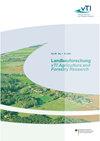The effect of a Niacin supplementation to different diets on ruminal fermentation and flow of nutrients to the duodenum of dairy cows
IF 0.7
4区 农林科学
Q3 AGRICULTURE, MULTIDISCIPLINARY
引用次数: 13
Abstract
The objective of this study was to investigate the influence of a niacin supplementation to three diets with different forage to concentrate ratios (F:C ratio) on ruminal metabolism of dairy cows. The rations consisted of either 2/3 forage and 1/3 concentrate, 1/2 forage and 1/2 concentrate or 1/3 forage and 2/3 concentrate on dry matter basis. Each diet was fed in one period without and in the following period with a supplementation of 6 g niacin (nicotinic acid, NA) per cow and day. Three dry and seven mid-lactating Holstein-Friesian cows, equipped with cannulas in the dorsal sac of the rumen and proximal duodenum were used. Ruminal fluid was obtained before and six times after the morning feeding, while duodenal chyme was collected every two hours for five consecutive days. Cr 2 O 3 was used as flow marker. NA supplementation increased rumen ammonia concentration, whereas it decreased short-chain fatty acid concentration. The amount of organic matter reaching the duodenum was enhanced if niacin was added to the rations. NA supplementation also led to higher flows of microbial protein and undegraded feed protein to the duodenum. Furthermore, the efficiency of microbial protein synthesis was enhanced in supplemented animals. The amounts of total niacin (the sum of NA and NAM) reaching the duodenum rose with increasing concentrate proportion and also with NA supplementation, whereas amounts of nicotinamide were only influenced by NA fee ding and not by the F:C ratio.不同饲粮中添加烟酸对奶牛瘤胃发酵及营养物质流向十二指肠的影响
本试验旨在研究在3种不同料精比(F:C)饲粮中添加烟酸对奶牛瘤胃代谢的影响。干物质基础饲粮为2/3粗料+ 1/3精、1/2粗料+ 1/2精或1/3粗料+ 2/3精。每种饲粮在第一阶段不添加烟酸,在第二阶段每头奶牛每天添加6 g烟酸(NA)。试验选用3头干奶牛和7头泌乳中期荷斯坦奶牛,在瘤胃背囊和十二指肠近端设置瘘管。晨饲前和晨饲后各取6次瘤胃液,每2 h采集一次十二指肠食糜,连续5 d。cr2o3作为血流标记物。添加NA提高了瘤胃氨浓度,降低了短链脂肪酸浓度。饲粮中添加烟酸可提高到达十二指肠的有机物数量。NA的添加还导致微生物蛋白和未降解饲料蛋白向十二指肠的流量增加。此外,微生物蛋白的合成效率也得到了提高。到达十二指肠的总烟酸(NA和NAM的总和)随精料比例的增加和NA添加量的增加而增加,而烟酰胺含量仅受NA添加量的影响,不受F:C比的影响。
本文章由计算机程序翻译,如有差异,请以英文原文为准。
求助全文
约1分钟内获得全文
求助全文
来源期刊

Landbauforschung
AGRICULTURE, MULTIDISCIPLINARY-
CiteScore
4.40
自引率
0.00%
发文量
0
审稿时长
>36 weeks
期刊介绍:
Die Landbauforschung Völkenrode – FAL Agricultural Research ist seit 1950 das wissenschaftliche Publikationsorgang der Bundesforschungsanstalt für Landwirtschaft. Sie wird von der FAL selbst herausgegeben, erscheint vierteljährlich und enthält sowohl deutsch- als auch englischsprachige Artikel.
In der Landbauforschung Völkenrode – FAL Agricultural Research werden Forschungsergebnisse der FAL veröffentlicht. Sie ist eine multidisziplinär ausgerichtete Zeitschrift, die die verschiedenen Facetten der Agrarforschung einschließt und besonderes Augenmerk auf deren interdisziplinäre Verknüpfung legt.
 求助内容:
求助内容: 应助结果提醒方式:
应助结果提醒方式:


